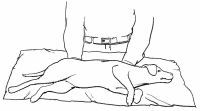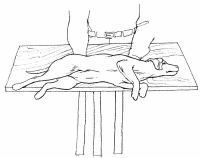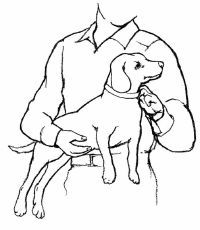How to Transport an Injured Dog
Once you've restrained the injured dog, you'll want to get it to a veterinarian as soon as possible. Try not to move a hurt dog more than necessary, and have someone call the veterinarian to be certain he or she is prepared for your arrival. In the meantime, use the following tips to help you transport your pet with the utmost care.
If the Dog Can Be Lifted
Step 1: If the dog is small:
Advertisement
Step 1a: Grasp its collar with one hand and place your other arm over its back and around its body.
Step 1b: At the same time, pull forward on the collar and lift the dog's body, cradling it against your body.
Step 2: If the dog is large:
Step 2a: Slip one arm under its neck, holding its throat in the crook of your arm. Be sure the dog can breathe easily.
Step 2b: Place your other arm under the dog's stomach. Lift with both arms.
Step 3: If the dog is very large, slip one arm under its neck, holding its chest in the crook of your arm. Be sure the dog can breathe easily. Place your other arm under the dog's rump and, pressing your arms toward one another, lift the dog.
Step 4: Transport the dog to the veterinarian.
If the Dog Needs a Stretcher

A flat board must be used if a broken back is suspected.
Step 1: Use a blanket or flat board as a stretcher. If you are using a board proceed to Step 2. If you are using a blanket:
Step 1a: Place one hand under the dog's chest and the other under its rear; carefully lift or slide the dog onto the blanket.
Step 1b: Transport the dog to the veterinarian.
Step 2: If you are using a flat board:

Step 2a: Depending on the size of the dog, use a table leaf, an ironing board, a large cutting board, or a removable bookshelf. Make sure whatever you use will fit in your car.
Step 2b: Place 2 or 3 long strips of cloth or rope equidistant under the board, avoiding the area where the dog's neck will rest.
Step 2c: Place one hand under the dog's chest and the other under its rear; carefully lift or slide the dog onto the board.
Step 2d: Tie the dog to the board.
Step 2e: Transport the dog to the veterinarian.
Another technique that can come in handy in many first-aid situations is giving oral medication to your pet. Check the next page for some helpful tips on administering medication.
